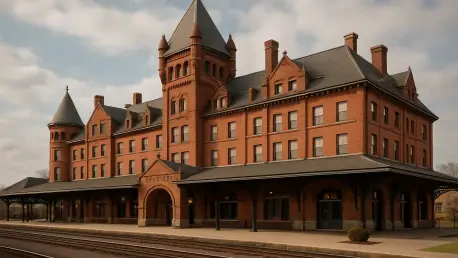What happens when the rhythmic clatter of locomotives fades into memory, yet the majestic structures of historic train stations stand defiant against time, preserving the echoes of rail travel’s golden age? Across the globe, these architectural relics are being reborn as luxury hotels, offering a unique blend of nostalgia and modern opulence. Picture stepping into a grand hall where once travelers rushed for their trains, now transformed into a lavish lobby with chandeliers casting light on preserved Victorian arches. This captivating trend of turning faded stations into five-star stays sparks curiosity about how such transformations unfold, preserving history while catering to today’s discerning guests.
The significance of this movement lies in its dual purpose: safeguarding cultural heritage and reimagining obsolete spaces for contemporary use. As rail travel declined in the 20th century, many iconic stations faced demolition or decay, threatening the loss of irreplaceable architectural gems. Converting these structures into luxury hotels not only saves them from ruin but also breathes new life into their stories, making history accessible to a global audience. This narrative explores the intricate process behind these revivals, from structural challenges to visionary designs, revealing why these projects matter in an era of rapid urbanization and evolving travel preferences.
Why Are Old Train Stations Turning into Five-Star Stays?
The allure of historic train stations lies in their grandeur, a testament to an era when rail was the pinnacle of travel. Built during the late 19th and early 20th centuries, these hubs often featured intricate designs—think soaring vaulted ceilings and ornate facades—that symbolized progress and ambition. As modern transportation shifted toward cars and planes, many stations fell into disuse, yet their architectural beauty remained undeniable, prompting a wave of reinvention as luxury accommodations.
This trend reflects a broader desire for unique travel experiences that connect guests with the past. Hotels housed in former stations offer more than just a place to stay; they provide a journey through time, where every archway or restored ticket counter tells a story. Properties like St Pancras in London have become destinations in their own right, drawing visitors who crave both historical immersion and the comforts of high-end hospitality, proving that nostalgia can be a powerful market force.
Beyond aesthetics, economic and cultural incentives drive these transformations. Governments and developers recognize the value of preserving landmarks as tourist attractions, often offering grants or tax breaks for adaptive reuse projects. Such initiatives ensure that instead of becoming forgotten ruins, these stations evolve into vibrant spaces that honor their legacy while meeting modern demands, creating a win-win for preservationists and the hospitality industry alike.
The Stakes of Saving Historic Hubs in a Modern World
Preserving historic train stations is not merely about maintaining old buildings; it’s about protecting a tangible link to cultural and industrial history. These structures often embody the spirit of their time, reflecting societal values through their design and function. Losing them to neglect or demolition means erasing chapters of human progress, a concern that has spurred global efforts to find sustainable new purposes for these spaces.
The challenge lies in balancing preservation with practicality in an urbanizing world. Many stations, built for a different era, lack the infrastructure for modern use, requiring costly renovations to meet safety and accessibility standards. Yet, the hospitality sector sees potential in these hurdles, transforming limitations into opportunities by marketing the unique character of these buildings as a draw for affluent travelers seeking authenticity over cookie-cutter experiences.
Adaptive reuse also aligns with sustainability goals, reducing the need for new construction by repurposing existing structures. This approach minimizes environmental impact while revitalizing communities, as seen in projects like St. Louis Union Station, which has become a cultural anchor in Missouri. By turning forgotten hubs into luxury destinations, cities gain economic boosts from tourism, ensuring these landmarks remain relevant for generations to come.
From Rails to Rooms: Key Elements of Transformation
Converting a historic train station into a luxury hotel is a complex endeavor that demands a delicate balance of preservation and innovation. Take St Pancras in London, where the iconic red-brick facade and soaring arches were meticulously restored during a £200 million renovation. Architects prioritized maintaining the building’s Victorian essence, ensuring that guests feel the weight of history even as they enjoy contemporary comforts like high-speed internet and plush bedding.
Structural challenges often pose significant obstacles in these projects. Many stations, built with outdated materials or designs, require innovative engineering solutions to accommodate modern needs. For instance, St Pancras faced issues with its thick concrete floors, originally a marvel of 19th-century construction, which complicated the installation of modern plumbing. Overcoming such barriers often involves collaboration between historians, engineers, and designers to preserve authenticity while ensuring functionality.
Blending old with new creates a signature appeal, as seen in diverse examples worldwide. St. Louis Union Station captivates with a 3D light show projected onto its historic Grand Hall, merging past and present in a visual spectacle. Meanwhile, Crowne Plaza Indianapolis Downtown Union Station offers rooms in converted Pullman train carriages, turning a nod to history into a unique selling point. These creative touches highlight how transformation projects craft unforgettable guest experiences by leveraging the past as a foundation for luxury.
Voices of Vision: Insights from Experts and Innovators
Behind every successful station-to-hotel conversion are visionaries who navigate the intersection of history and hospitality. Toland Grinnell, president of EverGreene Architectural Arts, underscores the importance of retaining what he calls the “historic fabric” of these buildings. His philosophy, applied in numerous restorations, emphasizes that innovation should enhance rather than erase the original character, a principle evident in the meticulous revival of gold-leaf details at St. Louis Union Station.
Practical insights from those on the ground reveal the real-world struggles of such ambitious projects. Edward White, general manager at St Pancras, describes the painstaking process of retrofitting Victorian infrastructure for today’s standards, from electrical systems to guest safety protocols. His account sheds light on the less glamorous side of preservation, where every decision must weigh historical value against operational needs, often under intense public scrutiny.
Cultural nuances also play a pivotal role, as illustrated by Tokyo Station Hotel’s commitment to “omotenashi,” the Japanese ethos of heartfelt hospitality. This dedication, woven into the guest experience alongside modern amenities like a state-of-the-art spa, shows how local traditions can elevate a hotel’s identity. These expert perspectives collectively paint a picture of transformation as both an art and a science, requiring passion, patience, and precision to succeed.
Blueprint for Revival: Steps to Transform a Station into a Hotel
Understanding the journey from station to hotel involves a structured approach that can guide future projects. The first critical step is assessing historical value, often through partnerships with historians and preservationists to pinpoint elements worth saving. For example, St. Louis Union Station’s intricate mosaics were identified as non-negotiable features, ensuring their restoration became a priority during planning.
Securing substantial investment follows as a cornerstone of success, given the high costs of such renovations. Tokyo Station Hotel’s transformation, backed by a 50 billion yen budget, exemplifies the financial commitment required to merge historical integrity with luxury standards. Developers must often navigate complex funding landscapes, blending private capital with public incentives to make these visions a reality.
Designing for dual purpose—honoring the past while embracing modern needs—requires careful planning, as does community engagement. Projects like St Pancras introduced unique rituals, such as a daily Victorian Punch Ritual, to captivate guests, while St. Louis leveraged its National Historic Landmark status to rally local support. These steps, from historical assessment to cultural integration, form a roadmap for turning relics of rail into bastions of luxury, ensuring each project resonates with both history buffs and modern travelers.
Reflecting on these remarkable transformations, it’s evident that the journey of historic train stations into luxury hotels is a triumph of vision over adversity. Each project, from the vaulted halls of London to the train carriage rooms of Indianapolis, overcame daunting challenges to preserve a slice of the past. Looking ahead, stakeholders must continue prioritizing adaptive reuse, seeking innovative funding models to support more conversions. Developers and communities should collaborate to identify at-risk stations, advocating for their revival as cultural and economic assets. By sustaining this momentum, the legacy of rail travel’s golden age can endure, inviting future generations to step into history with every luxurious stay.









